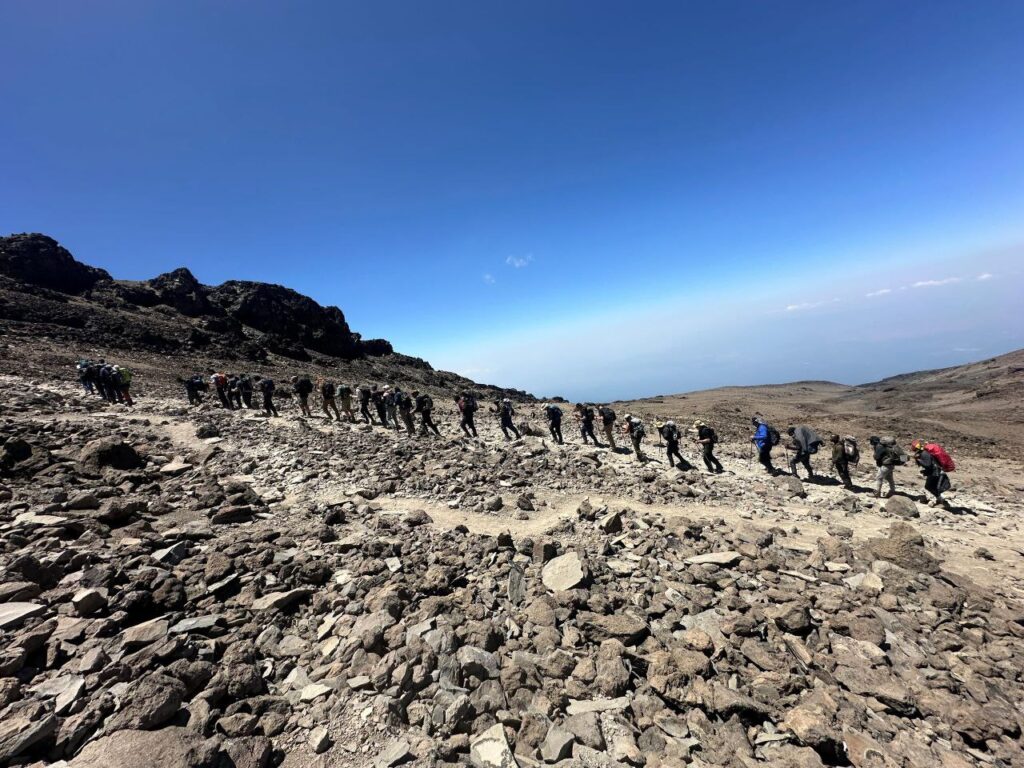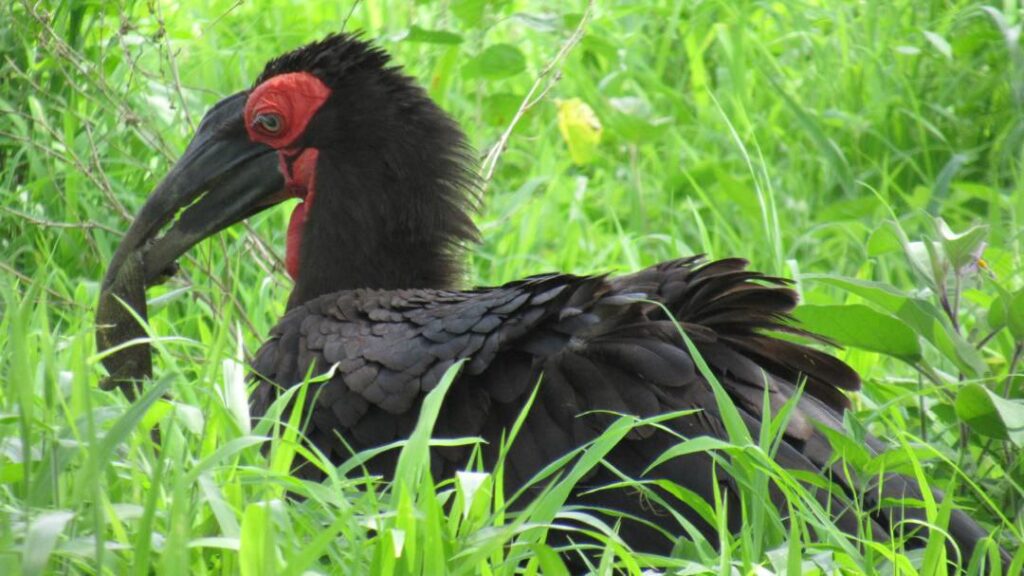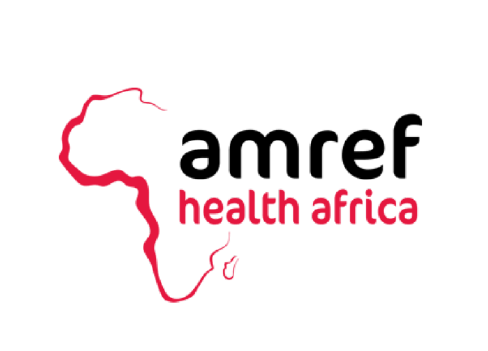Imagine standing at the edge of a vast, mist-shrouded rainforest, the air thick with the calls of exotic birds and the earthy scent of blooming orchids. As the sun pierces through the canopy, revealing glimpses of Africa’s highest peak, you realize this isn’t just a hike—it’s a journey through time, from lush jungles to alpine deserts, culminating in the triumphant roar of “Pole Pole!” (slowly, slowly) as you summit Uhuru Peak.
Welcome to the Lemosho Route Kilimanjaro, a hidden gem among the mountain’s many paths. For adventurers seeking remote Kilimanjaro trekking experiences that prioritize breathtaking scenery over bustling crowds, this route delivers an unforgettable scenic Kilimanjaro climb in East Africa.
At Africa Paradise Adventures, we’ve guided countless trekkers along this enchanting trail, witnessing their awe at its unspoiled beauty and the profound sense of solitude it offers. Unlike the more popular Marangu or Machame routes, the Lemosho starts in the remote western flanks of Mount Kilimanjaro, weaving through diverse ecosystems that showcase the mountain’s geological wonders. With a success rate hovering between 85% and 95%, it’s not just visually stunning—it’s strategically smart for acclimatization, minimizing the risks of altitude sickness.
In this guide, we’ll dive deep into why the Lemosho Route stands out, from its day-by-day itinerary to practical tips for preparation. Whether you’re a seasoned hiker or a first-time climber, read on to discover how this path can transform your East African adventure.
Why the Lemosho Route is the Ultimate Choice for Remote Kilimanjaro Trekking
Mount Kilimanjaro, Africa’s rooftop at 5,895 meters (19,341 feet), draws over 30,000 climbers annually, but not all routes are created equal. The Lemosho Route Kilimanjaro shines as a beacon for those craving authenticity and tranquility. Opened in the 1990s as an alternative to overcrowded paths, it begins in the lesser-visited Londorossi Gate, far from the throngs of tourists. This remoteness translates to a more intimate connection with the landscape—no endless lines of porters and climbers jostling for space.
What sets the Lemosho apart in the realm of scenic Kilimanjaro climbs East Africa? Its gradual ascent profile. Spanning 7 to 9 days (with the 8-day version being the sweet spot for most), it covers about 70 kilometers, allowing your body to adapt to thinning oxygen levels. According to insights from Africa Paradise Adventures, this extended timeline boosts summit success by providing “climb high, sleep low” opportunities—essential for combating acute mountain sickness (AMS).
But the real magic lies in the scenery. Trekkers often describe the Lemosho as a “visual symphony,” transitioning seamlessly from montane forests teeming with colobus monkeys to heather moorlands dotted with giant lobelias, and finally to the ethereal Shira Plateau’s alpine meadows. It’s less crowded because it starts off the beaten path, merging with the popular Machame route only on day four, giving you three days of near-solitude. For eco-conscious travelers, the route’s lower traffic means minimal environmental impact, aligning with sustainable tourism principles championed by operators like Africa Paradise Adventures.
In a region where East Africa’s big game safaris steal the spotlight, the Lemosho offers a quieter thrill: wildlife spotting without the jeep traffic. Buffalo herds grazing in the heath zones, elusive leopards in the shadows, and a riot of birdlife from turacos to sunbirds. If you’re dreaming of a remote Kilimanjaro trekking escape that feels worlds away from the safari circuits, this route is your portal.
A Day-by-Day Breakdown: The 8-Day Lemosho Route Itinerary

Day 1: Arrival in Moshi and Transfer to Londorossi Gate (Elevation: 2,100m to 2,360m)
Your scenic Kilimanjaro climb in East Africa kicks off with a scenic drive from Kilimanjaro International Airport to our base in Moshi, the gateway to the mountain. After a briefing at Africa Paradise Adventures’ comfortable lodge—complete with Swahili-inspired meals and gear checks—you’ll head to Londorossi Gate. A short 3-hour hike (6km) through rainforests introduces the route’s lush underbelly. Camp at Lemosho Big Tree (2,650m), where porters set up your tent amid ancient podocarpus trees. Dinner under the stars: hearty ugali and fresh veggies. (Hiking time: 2-3 hours; Difficulty: Easy)
Day 2: Lemosho Big Tree to Shira Ridge (Elevation: 2,650m to 3,550m)
Dawn breaks with mist rolling off the forest floor as you trek 7km uphill (4-5 hours). The path narrows into a game trail, perfect for remote Kilimanjaro trekking vibes—spot blue monkeys swinging overhead and wildflowers carpeting the trail. Emerging onto the Shira Plateau feels like stepping into another world: vast grasslands backed by the snow-capped Kibo Peak. Camp at Shira One (3,500m), where the air crisps and the views stretch to the Indian Ocean on clear days. Pro tip: Hydrate early; porters serve ginger tea to ease the altitude nudge.
Day 3: Shira Ridge to Shira Cathedral and Camp (Elevation: 3,550m to 3,840m)
Today’s 10km jaunt (5-6 hours) is a highlight for scenery lovers. Ascend to Shira Cathedral (3,840m), a rocky outcrop offering 360-degree panoramas of the Shira Caldera—a dormant volcanic remnant that’s a geologist’s dream. Descend slightly to camp at Shira Two (3,750m), emphasizing acclimatization. Evenings here are magical: stargazing sessions led by your guide, who shares Chagga folklore about Kilimanjaro’s spirits. Meals feature nyama choma (grilled meats) to fuel your body.
Day 4: Shira Camp to Barranco Valley (Elevation: 3,750m to 3,950m)
Merging with the Machame route, this 10km stage (6-7 hours) climbs to Lava Tower (4,600m) for a high-altitude “taste” before dropping to Barranco Camp (3,950m). The “non-technical” scramble up the tower builds confidence without ropes. En route, traverse moorlands ablaze with red-hot pokers and proteas. This yo-yo elevation is key to the Lemosho’s 90%+ success rate, as noted in Africa Paradise Adventures’ route comparisons. Camp beneath the dramatic Barranco Wall—a sheer granite face that looms like a natural fortress.
Day 5: Barranco Wall to Karanga Valley (Elevation: 3,950m to 4,000m)
The infamous “Wall” ascent (5km, 4-5 hours) is steeper than it looks but rewarding, with cables for support. It’s a rite of passage, testing grit amid stunning vistas of the southern ice fields. Descend to Karanga (4,000m), a dry valley where hardy senecios tower like alien sentinels. This shorter day allows rest, vital for oxygen adaptation. Guides from Africa Paradise Adventures often lead optional yoga sessions here to stretch sore muscles.
Day 6: Karanga to Barafu Camp (Elevation: 4,000m to 4,680m)
Pushing 6km (4 hours) through alpine desert, the landscape turns stark and surreal—volcanic scree underfoot, glaciers glinting in the distance. Barafu Camp (4,680m) is base for the summit, a windy perch with tents huddled against the chill. Fuel up on carb-heavy pasta; early bedtime after a briefing. The thin air here humbles even veterans, but the Lemosho’s pacing ensures you’re ready.
Day 7: Summit Night to Uhuru Peak and Descent to Mweka (Elevation: 4,680m to 5,895m to 3,100m)
Midnight wake-up: Headlamps bob as you assault Stella Point (5,756m) via scree slopes (6-8 hours up). At dawn, the crater rim bursts into color—crimson skies framing Mawenzi’s jagged silhouette. Uhuru Peak! Champagne toasts, certificates, and tears of joy. Descend 1,500m in 3-4 hours to Mweka Camp (3,100m), legs like jelly but hearts full. The euphoria of a Lemosho Route Kilimanjaro summit lingers.
Day 8: Mweka to Moshi (Elevation: 3,100m to 1,800m)
A gentle 9km downhill (3-4 hours) through cloud forest rewards with waterfalls and bird choruses. Back in Moshi, celebrate with a farewell feast at Africa Paradise Adventures’ lodge—perhaps a Tanzanian barbecue. Airport transfer seals the adventure.
This itinerary, customizable via our team, embodies the essence of scenic Kilimanjaro climbs East Africa: diverse, demanding yet doable.
The Scenic and Wildlife Highlights of the Lemosho Route

No discussion of remote Kilimanjaro trekking is complete without its natural spectacles. The Lemosho’s western approach gifts views of the Shira Plateau’s expansive caldera, a collapsed volcano larger than most craters worldwide. Heather zones explode in color: yellow everlasting flowers and purple heathers create tapestries underfoot.
Wildlife adds intrigue. While not a safari, the route’s seclusion invites encounters—elephants occasionally roam the lower forests, buffalo wallow in marshes, and klipspringers bound across rocks. Birders tally over 100 species, from silvery-cheeked hornbills to malachite kingfishers. At higher elevations, the “impossible” giant groundsels and lobelias, adapted to freezing nights, evoke lunar landscapes.
Geologically, it’s a timeline: Rainforests from 2 million years ago, ash cones from recent eruptions. Photographers, take note—the golden hour on Shira Ridge rivals any East African sunset.
Acclimatization, Safety, and Health on the Lemosho Route
Success on Kilimanjaro hinges on acclimatization, and the Lemosho excels here. Its 8-day format allows multiple “climb high, sleep low” cycles, reducing AMS risks (headaches, nausea) to under 10%. Africa Paradise Adventures mandates Diamox for susceptible climbers and monitors vitals with pulse oximeters.
Safety is paramount: Our guides, certified by the Kilimanjaro National Park Authority, carry emergency oxygen and satellite phones. Weather can turn—equatorial snowstorms are rare but possible—so layered clothing is non-negotiable. Women trekkers appreciate our female porters and private facilities.
Preparing for Your Lemosho Adventure: Tips from the Experts
Ready for Lemosho Route Kilimanjaro? Start training 3-6 months out: Cardio (hiking with packs), strength (squats, lunges), and stairs for endurance. Pack wisely—hiking boots, down jacket, trekking poles—and consult our gear list.
Visas for Tanzania are straightforward; malaria prophylaxis advised for lowlands. Budget for tips ($250-300 total) and travel insurance covering evacuation.
The Lemosho Route Kilimanjaro isn’t just a climb—it’s a reclamation of wonder in a crowded world. From remote trails alive with East Africa’s pulse to the silent majesty of Uhuru Peak, it redefines adventure. Ready to lace up? Contact Africa Paradise Adventures today at info@africaparadiseadventures.com or visit our site to book your scenic Kilimanjaro climb in East Africa.





